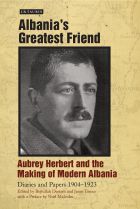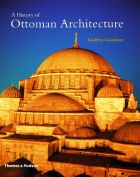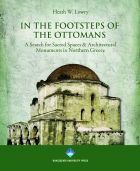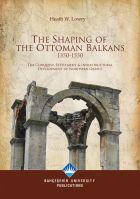Buy or gift a stand-alone digital subscription and get unlimited access to dozens of back issues for just £18.99 / $18.99 a year.
Please register at www.exacteditions.com/digital/cornucopia with your subscriber account number or contact subscriptions@cornucopia.net
Buy a digital subscription Go to the Digital EditionWith a taste for adventure Indiana Jones would appreciate, the Dutch architectural historian Machiel Kiel has risked life and limb in his mission to expose the annihilation of Ottoman monuments in the Balkans. The art historian Holta Vrioni pays tribute to his work and exploits
We often hear of journalists risking, even losing, their lives sneaking into dangerous zones to report crimes against lands and peoples. But you hardly expect to read of a scholar taking such risks in the course of his studies. Jumping from a hotel window to escape the attention of a regime’s minions in order to visit a site; diverting Red Guard chaperones with the lure of beautiful women while you sneak a few measurements; plying the regime’s “tour guides” with whisky and ending up incarcerated… Such tales come as something of a surprise from an art historian merely trying to study Ottoman architecture.
One cannot overstate Machiel Kiel’s contribution over five decades to the study of the cultural and architectural legacy of the Ottoman Balkans. What is more, his pioneering research was mostly carried out during the Cold War, when extreme political constraints made surveys of any nature hazardous – his resolve did indeed embroil him in many adventures, not least a prison sojourn in Bulgaria.
Born in 1938 in the small village of Wormerveer, in northern Holland, Kiel developed an early taste for stone monuments, thanks to a teacher’s fervour for architecture. A solo bicycle tour of the medieval monuments of northwest Holland was a prelude to subsequent trips on the Soviet buses that ran the Balkan roads hardly faster than a Dutch bicycle.
Kiel started his career as a restorer, working for several years at the National Service of Historical Monuments of the Netherlands. His first encounter with Ottoman architecture occurred in Greece in 1959, where he was involved in the restoration of the waterworks in Ioannina, after which he made his first visit to Yugoslavia.
The mid-1970s marked two turning points in Kiel’s life. First a work accident in 1976 ended his career as a restorer and encouraged him to devote his time to his studies at Amsterdam University. The second was meeting the renowned Turkish historian Ekrem Hakkı Ayverdi, by then over 70 and about to complete his inventory of Ottoman monuments in the Balkans. Meeting at Ayverdi’s house in Istanbul, the two realised they shared many interests. While Ayverdi encouraged Kiel’s enthusiasm for the transcription of Ottoman epigraphy, he could not match Kiel’s reading skills in Serbo-Croatian and Bulgarian or his acute talent for long-term observation developed during his field trips. Kiel attributes the disarming directness of his defence of Ottoman architecture to his “Dutchness”, but it was sharpened without a doubt in that house in the heart of the Imperial City. To this day Kiel acknowledges his indebtedness to the “Altmeister” for some of his deepest insights, transmitted during countless hours of conversation and correspondence.
After publishing his doctoral thesis, Art and Society of Bulgaria in the Turkish Period in 1985, Kiel began teaching Islamic architecture at Utrecht University and thereafter lectured or researched in Paris, Munich, Durham and at Harvard. It was, however, the publication in 1990 of Ottoman Architecture in the Balkans and Ottoman Architecture in Albania that fully revealed the inimitable “Kiel method”, a combination of material and textual inquiry in the fields of architecture and inscriptions with demographic and other archival research.
He brought his method to bear on the study of tahrir (population and tax registers), mühimme (registers of correspondence between the Divan and the provinces), tapu (title deed registers), vakıf (registers of pious foundations), icmal defterleri (registers of census and taxation) and salnâme defterleri (official yearbooks for each Ottoman province, started in the 1860s), and often applied it to the study of a single building. This set an unprecedented standard for placing Ottoman architecture in its historical context.
I came across Kiel’s remarkable Ottoman Architecture in Albania while conducting my own research on the largest ayan konaks (seraglios, in local vernacular) of the former Ottoman Albanian provinces – Ottoman rule lasted from 1385 to 1912. Published some 22 years ago, Ottoman Architecture in Albania remains the only comprehensive study of the subject, essential reading for any scholar with an interest, and a wonderful read for initiated amateurs too. The monograph nonetheless remains disturbingly unknown to the Albanian reader.
Fascinated by the extraordinary fact that Kiel’s research on Ottoman Albania was carried out under the draconian travelling restrictions of Albania’s North Korean era, I asked him to tell me how on earth he had managed it. I intended to publish his account concurrently with my Albanian-language translation of his monograph (soon to see the light of day thanks to the publisher of the original English edition). Kiel was happy to comply.
With no official permission to conduct research, Kiel’s fieldwork took place during his three visits as a tourist. Short on roubles after the breakaway from the Soviet Union and envying the tourist dollars pouring into Greece and Yugoslavia, the authorities decided to open the country’s door, just a crack, and solely for organised cultural visits. Kiel was among the first Westerners admitted.
In the cities his tour group was ushered around by guides – the regime’s lackeys. He was allowed to photograph certain historical edifices, and learnt to sketch plans quickly. In Albania he developed a technique for measuring Ottoman edifices: while a couple of stunning women from the tour group distracted their gullible guides, he rapidly took some of the monuments’ essential measurements. In such absurd circumstances Kiel’s great sense of humour was invaluable.
His first visit to the People’s Republic occurred in 1967, six months after the regime started its cultural revolution and declared Albania the world’s first atheist land. Anti-religious hysteria had left lofty minarets lying shattered across main city streets, blocking traffic entirely. Elsewhere flyers informed people how to tear down a minaret: “Attach a strong rope around the balcony, collect 30–40 strong people and start pulling; let loose, then pull again until it falls down.”
But nothing compared to the “horrifying vision of the Day of Resurrection” Kiel experienced during a perilous escapade to visit a Sufi lodge, or tekke, in the village of Turan, near Görice (Korçë). The interior of the türbes next to the tekke, originally containing the tombs of a few Bektashi sheikhs, had been removed days earlier. In the graveyard graves stood open, bodies removed, their shoes and jackets lying around on the ground. The buildings now housed a chicken farm. Thanks to this incident we learnt that Bektashi dervishes could also be buried with their clothes – “a curious thing”, as Kiel puts it.
On his second journey, in the 197os, Baroness van Heemstra, from an old aristocratic Dutch family (Audrey Hepburn’s mother was also a Baroness van Heemstra), joined his tour group. The baroness offered an introduction to her husband, the Dutch ambassador to Belgrade, who was also accredited in Albania. Schelto, Baron van Heemstra, visited Kiel in Wormerveer, where the latter shared piquant stories of his field research in Albania and showed him copies of his drawings, expressing concern as to their accuracy. Van Heemstra agreed to take them along on one of his official journeys to Albania and have them confirmed by the Tirana Institute of Monuments of Culture. Naturally, the Albanians were perplexed by a diplomat possessing such plans during the Cold War. Although Van Heemstra’s response – “Well, we diplomats have our own channels” – probably added to their confusion, he managed to have the plans corrected and returned safely to Kiel.
Kiel did not publish his Ottoman Architecture in Albania before one further visit to the country, in 1983. The work is an impressive scrutiny of centuries of religious and military Ottoman monuments. Though many old bridges, minor mosques and monumental dervish convents in villages and smaller towns forbidden to foreign travellers escaped his attention, other fine examples of classical Ottoman architecture – their proportions, decorative elements and superb masonry – did not. One such is the Mirahor Mosque of the illustrious Ilyas Bey, master of the imperial stables of Beyazıd II, who by building a mosque and his own türbe in his birthplace in 1495 laid the foundations of the flourishing town of Görice (Korçë). Another is Süleyman the Magnificent’s Mosque in Avlonya (Valona/Vlora), built during his 1537 Corfu campaign by his illustrious architect Sinan. Yet another is the Kurflunlu Mosque in Berat, built by the Albanian family of a Beylerbeyi of Anatolia who died in the Hungarian campaign in 1479.
Few Ottoman monuments, however, survived the tumult of time and modernity, with 97 percent of the Ottoman stone heritage erased entirely. Some were destroyed by the Ottoman authorities themselves in the cause of modernisation. The marvellous Castle of Avlonya, constructed for Süleyman in 1537 and Sinan’s most impressive military monument on the Adriatic, was destroyed in 1906 to make way for a road from the port to the city centre. Others perished for similar reasons shortly before Zog I was proclaimed King of the Albanians. The marvellous Avlonyalı Konak vanished in 1925, with its beautiful 40,000-square-metre park, vast harem and selamlık.
The greatest massacre came during the People’s Republic years, with entire cities forever disfigured. Kavalya (Kavaja), a wonderful Ottoman foundation of 1561 near Draç (Durrazo), took Evliyâ Çelebi’s breath away in 1690. Peklin (Peqin) owed its beauty to its native son Abdurrahman Pasha, Ağa of the Janissaries of Mehmed IV, former governor of Egypt and Baghdad and last Ottoman governor of Buda, killed in battle in 1686.
Machiel Kiel’s Art and Society of Bulgaria in the Turkish Period quotes the Arab Christian philosopher William Haddad: “The national state is the prison of the mind” – a prison that imposes narrow perspectives and prevents things from being seen in their greater context. It is for this reason that, as Kiel would put it, Ottoman architecture in the Balkans remains an unwanted heritage.
Books by Machiel Kiel: ‘Art and Society of Bulgaria in the Turkish Period’ (Van Gorcum 1985); ‘Ottoman Architecture in Albania 1385–1912’ (ircica 1990); Ottoman Architecture in the Balkans (Variorum 1990)
Holta Vrioni researches and writes about the arts and history
The editor must apologise for the fact that the photograph of Machiel Kiel with an owl on his shoulder was inadvertently incorrectly credited in the article published in Cornucopia 47. The remarkable portrait was in fact by the talented photographer Dr Aras Neftçi, of the Faculty of Architecture at the Istanbul Technical University, author coincidentally of an excellent study on the ‘bird houses’ of Istanbul: Istanbul’un Yüz Kuşevi
Over the past decade Turkey’s wine industry has come of age. It is now more than ready to join the grown-ups of the wine-producing world. Kevin Gould and the Cornucopia team pick the best of a sparkling bunch. Photographs by Berrin Torolsan.
Cornucopia’s self-guided wine tours
The First Balkan War, a hundred years ago, is an obscure affair, overshadowed by the First World War that followed. But it ended the Ottoman Empire in Europe and came close to ending Turkey itself. It left almost half a million refugees and three times as many dead. David Barchard tells the story of a catastrophic conflict
When Amsterdam’s renovated Rijksmuseum reopens in 2013, the public will be able to visit the Turkish Cabinet of Cornelis Calkoen, the Dutch republic’s ambassador to Istanbul from 1727 to 1744. For more than a century now the museum has been the keeper of his collection of paintings.
‘Never swim before the first watermelon rind falls into the water,’ goes an old Istanbul saying. By the time they ripen, the sea will have reached just the right temperature for swimming.
She was born to be a New York society beauty, but the late Josephine Powell’s chosen world was that of the Anatolian Nomad. Five years after her death, her archive of photographs recording old Anatolia in all its glory will see the light of day in Istanbul
As Turkey and the Netherlands celebrate
400 years of fruitful trade with a series of spectacular exhibitions in both countries, Philip Mansel, author of a new history of the Levant, reflects on the curious role of the Dutch at the Sublime Porte
Not far from the World Heritage city of Safranbolu lies the quiet village of Yörük Köyü, once famed for its valiant cavalry. Berrin Torolsan continues her series on Anatolia’s country houses with a visit to the Sipahioğlu Konak, a beautifully built mansion of satisfying simplicity and unassuming flair.
Rather than follow the crowd and dismiss Ankara as a dull, soulless modern capital, says Patricia Daunt, visitors should take time to discover why the famed Angora of old, twice capital in ancient times, is back on the map.





Cornucopia works in partnership with the digital publishing platform Exact Editions to offer individual and institutional subscribers unlimited access to a searchable archive of fascinating back issues and every newly published issue. The digital edition of Cornucopia is available cross-platform on web, iOS and Android and offers a comprehensive search function, allowing the title’s cultural content to be delved into at the touch of a button.
Digital Subscription: £18.99 / $18.99 (1 year)
Subscribe now